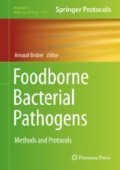Abstract
We present a protocol for the study of inter and transgenerational behavioral responses to pathogenesis in C. elegans. Transgenerational and intergenerational effects of microbes are best studied in model organisms with short life cycles, large progenies, and quantifiable cellular and behavioral outcomes. This chapter encompasses basic techniques used to study the consequences of bacterial infection in C. elegans, including worm growth, quantification of dauer larvae, and quantification of bacterial population dynamics within individual animals. Specific methods for studying transgenerational effects and their duration are also described.
Access this chapter
Tax calculation will be finalised at checkout
Purchases are for personal use only
Notes
- 1.
Changes between different bacteria mean animals grown for one generation on either pathogens (P. aeruginosa, S. Typhimurium) or non pathogens (E. coli OP50) and changed to other of the trio in the next generation, as embryos.
References
Klengel T, Dias BG, Ressler KJ (2016) Models of intergenerational and transgenerational transmission of risk for psychopathology in mice. Neuropsychopharmacology 41:219–231
Palominos MF, Verdugo L, Gabaldon C et al (2017) Transgenerational diapause as an avoidance strategy against bacterial pathogens in Caenorhabditis elegans. MBio 8:e01234–e01217
Skinner MK (2011) Environmental epigenetic transgenerational inheritance and somatic epigenetic mitotic stability. Epigenetics 6:838–842
Dias BG, Ressler KJ (2014) Experimental evidence needed to demonstrate inter- and trans-generational effects of ancestral experiences in mammals. BioEssays 36:919–923
Author information
Authors and Affiliations
Corresponding author
Editor information
Editors and Affiliations
Rights and permissions
Copyright information
© 2019 Springer Science+Business Media, LLC, part of Springer Nature
About this protocol
Cite this protocol
Chávez, F.P., Calixto, A. (2019). Use of C. elegans Diapause to Study Transgenerational Responses to Pathogen Infection. In: Bridier, A. (eds) Foodborne Bacterial Pathogens. Methods in Molecular Biology, vol 1918. Humana, New York, NY. https://doi.org/10.1007/978-1-4939-9000-9_16
Download citation
DOI: https://doi.org/10.1007/978-1-4939-9000-9_16
Published:
Publisher Name: Humana, New York, NY
Print ISBN: 978-1-4939-8999-7
Online ISBN: 978-1-4939-9000-9
eBook Packages: Springer Protocols

